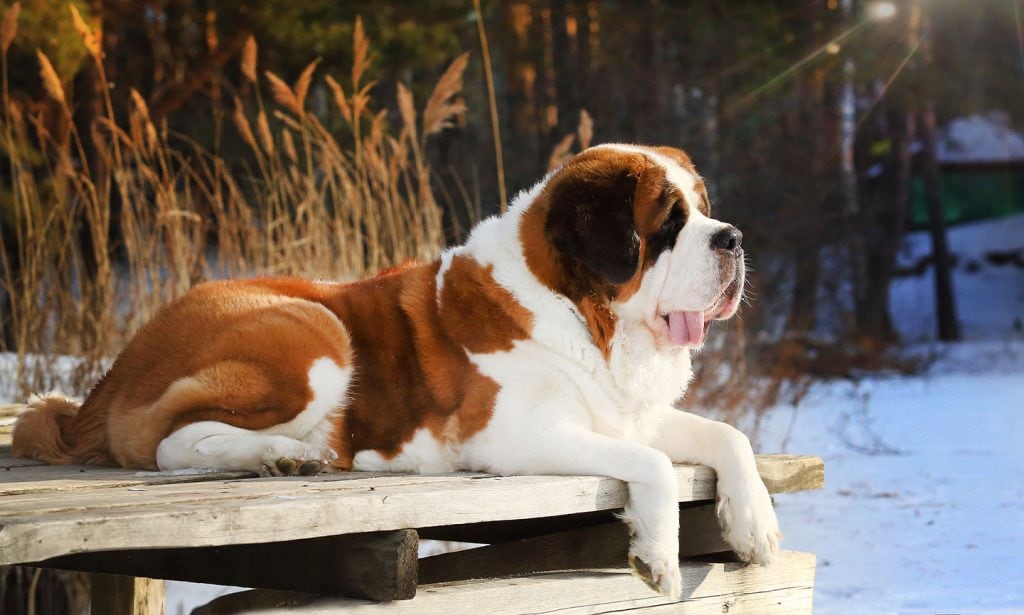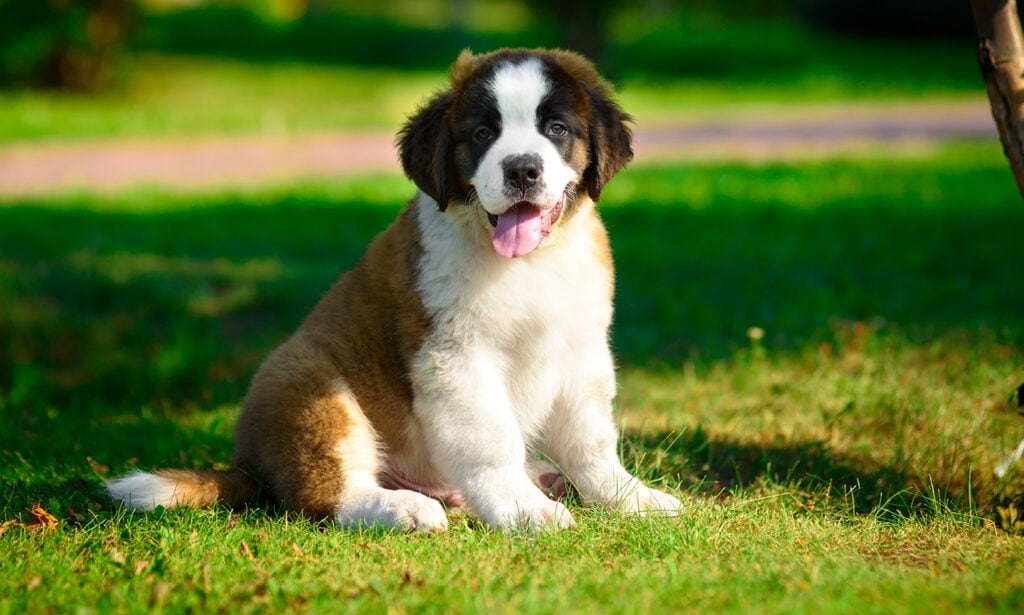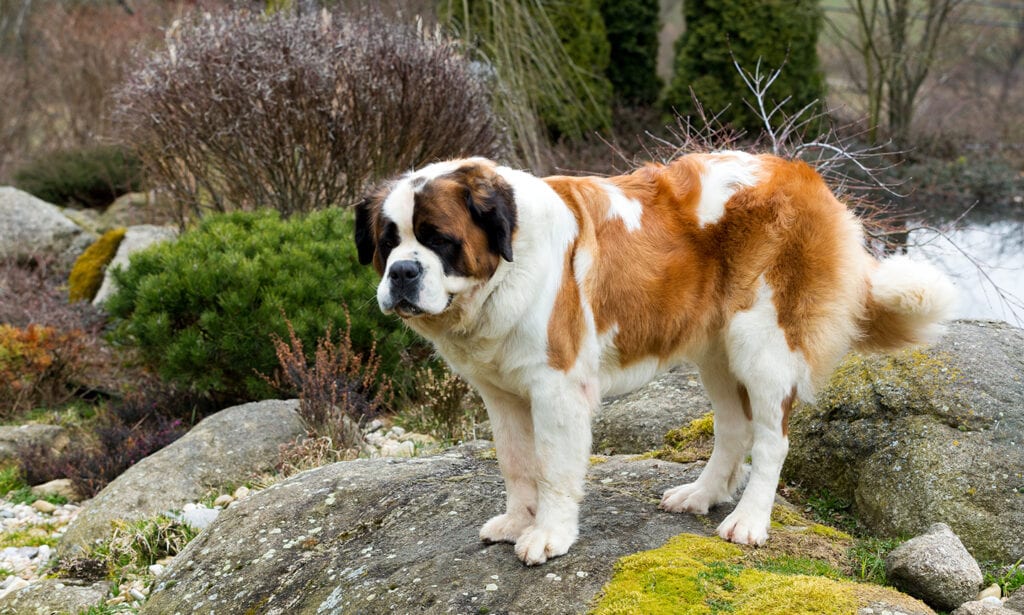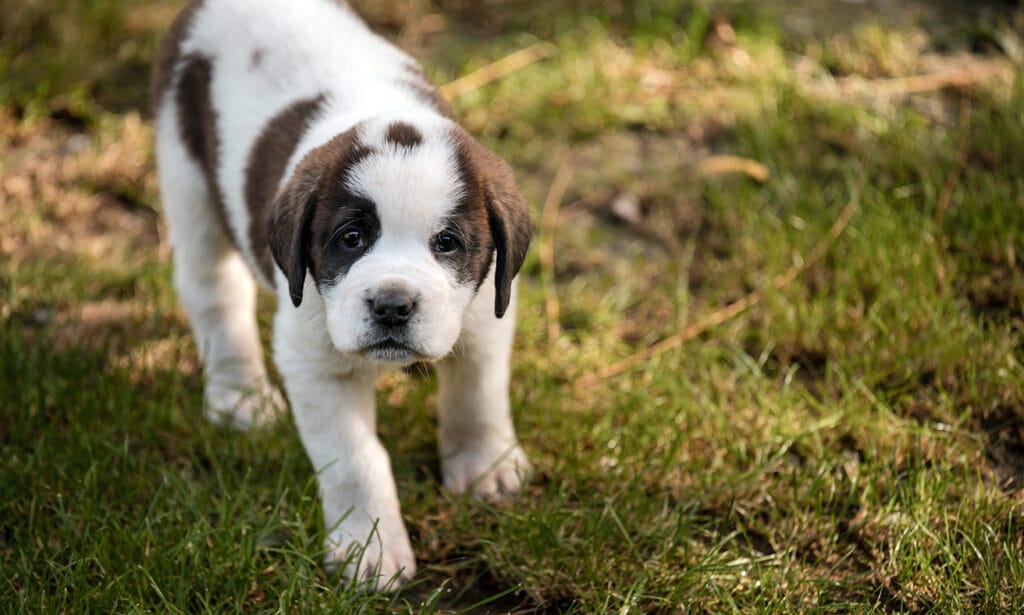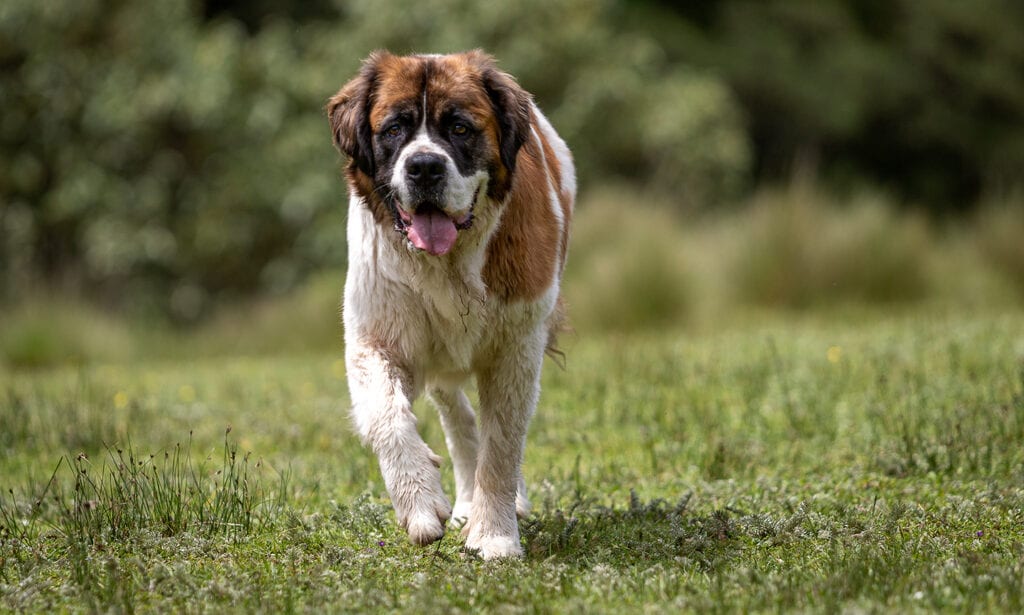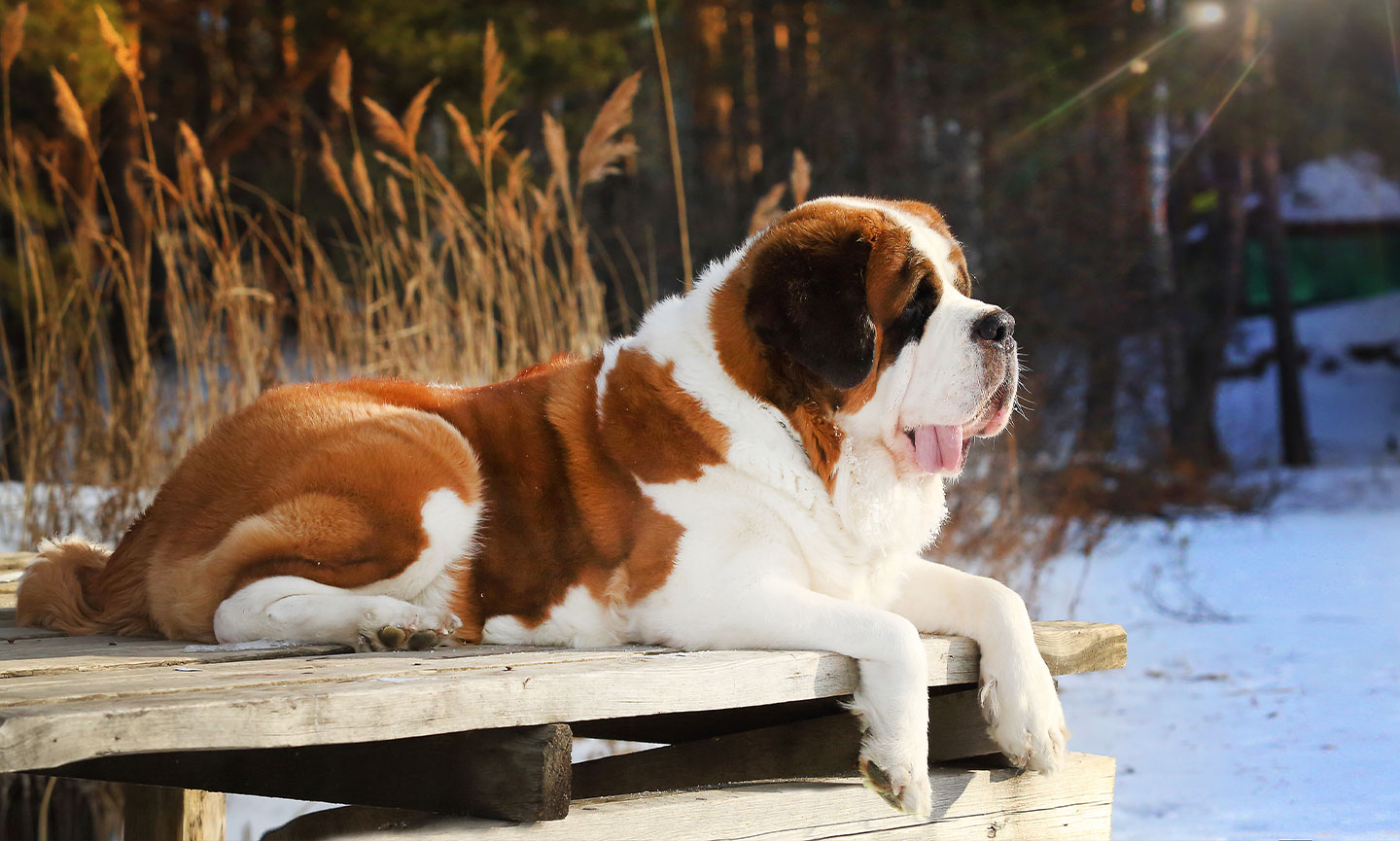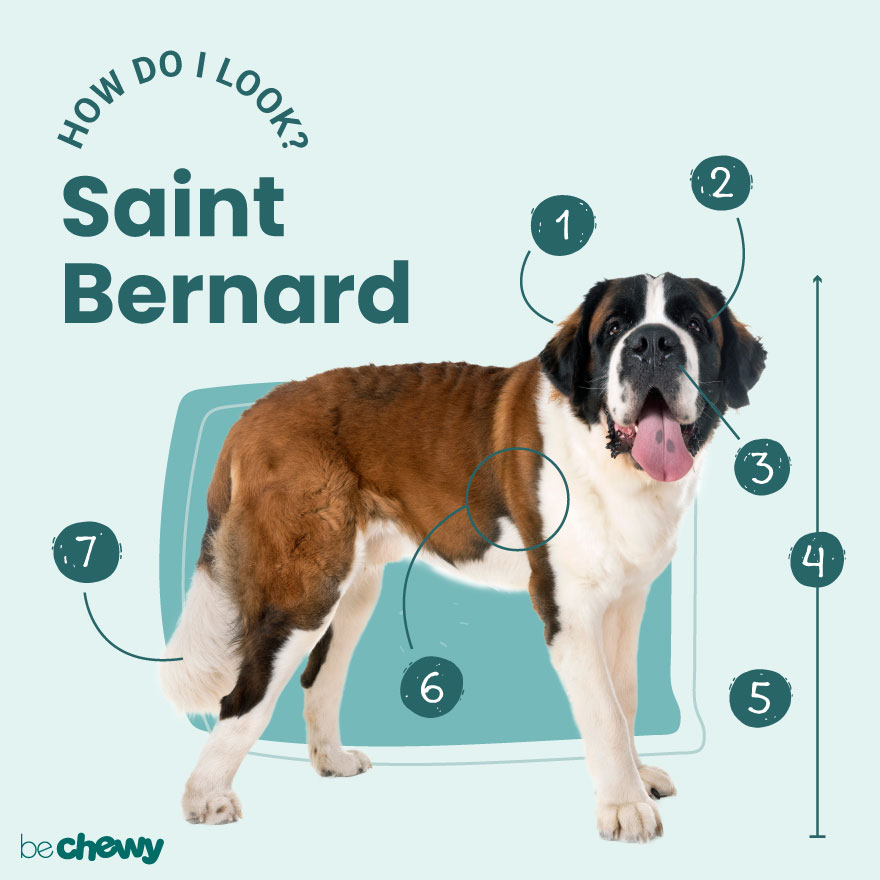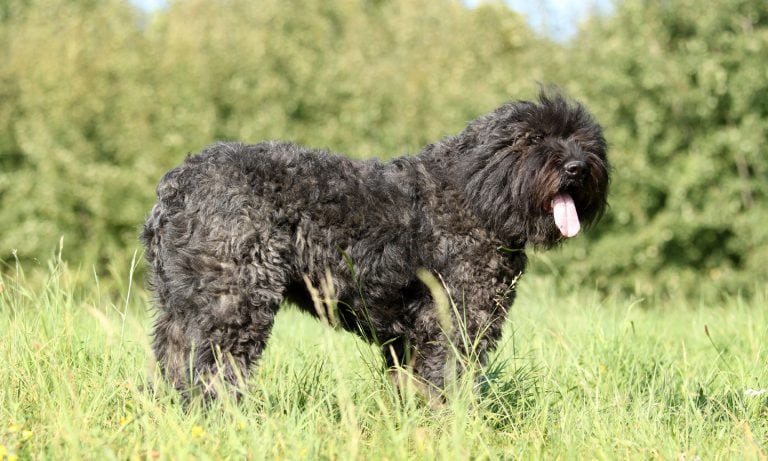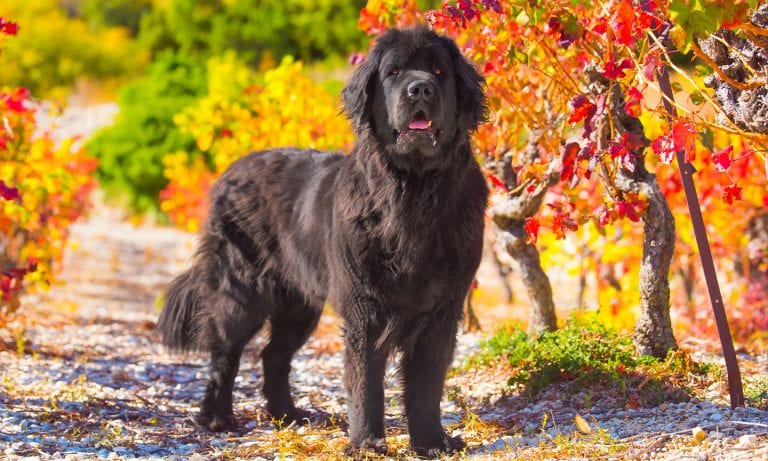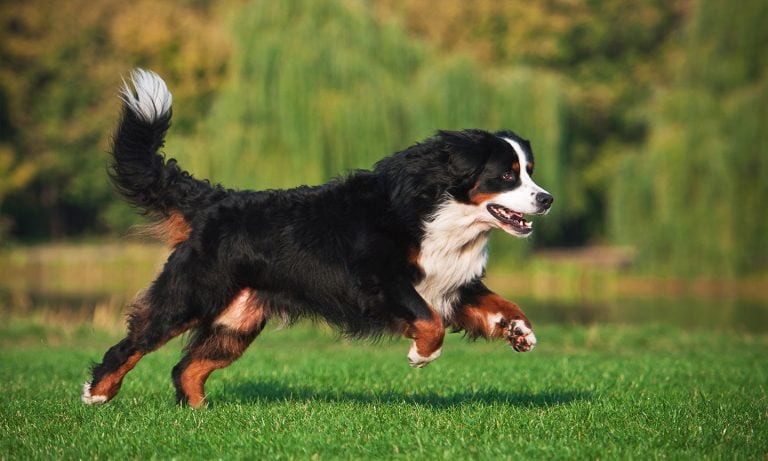Get ready to be a people magnet. Whether playing fetch at the dog park or cruising your neighborhood sidewalks, the large and lovable Saint Bernard naturally attracts attention wherever they go. Children eagerly hug (and ask to ride) these oversized teddy bears, and adults swoon when peering into a Saint’s soulful eyes. But don’t worry, Saint Bernards are happy to let you be the superstar in the relationship and content to be your attentive, calm companion. Leisure lovers will always have a willing sidekick, as this mellow dog loves anything slow-paced and won’t say “no” to a night of Netflix and chillaxing on the couch. Just don’t expect them to give you much room after they stretch out their 100-plus pounds of floofy cuteness.
Breed Snapshot
Temperament:
Laid BackSocial Teddy BearAttentive FriendCoat Color:
Brown And WhiteMahogany And WhiteOrange And WhiteRed And WhiteBrindle And WhiteRust And WhiteWhite And BrownWhite And OrangeWhite And Red
Best For
Drooly gentle giants, Saint Bernards are best for larger homes with experienced pet parents who can provide lots of focused training and regular exercise—and keep up with their grooming needs. Known for their calm and affectionate nature, these teddy bears are kid- and pet-friendly, to boot.
Saint Bernard Temperament
Would you ever expect your personal bodyguard to be mistaken for a floofy teddy bear? Probably not, but you should. (Because: safety first. And also because: adorable.) Saint Bernards’ gentle, calm demeanor with a dash of playfulness are a natural fit for homes with older children, other dogs and even friendly felines. They’ll also mesh with younger children, but littler kiddos will need extra supervision to ensure they can respect your pup’s boundaries.
A Saint Bernard dog doesn’t always comprehend just how big they are, which can cause some consternation and tears when playing with tipsy tots or unstable adults (or tipsy adults, for that matter). Training for both humans and the dog is a must to be sure nobody accidentally gets knocked over during backyard romps or in-home zoomies. Saints are friendly dogs (and they swear they didn’t mean to knock you down! They thought you were trying to start a game of tag!) and will stay that way with a loving home and positive reinforcement-based training. In general, Saints are not known to bite, but it’s always important to properly socialize and train any dog. Socializing your Saint Bernard puppy before 20-24 weeks of age allows your outgoing pup to learn good manners and blossom as a beloved family pet.
If it looks like you’re going to do something fun, Saints will want to join you, no questions asked. They’re in the car before you can even find your keys, ready for a nature trail adventure or a Sunday drive through the country. Whatever their human is doing, they want to mirror the activity or supervise from a cozy spot next to your feet.
If you have a job you need doing, give it to a Saint, and they will be more than happy to check it off your to-do list. Saint Bernards are a working breed who love to help people. Give them a chore, like helping feed livestock on a farm or serving as a door greeter at your small business, and they’ll be happy campers. Saints are eager to please. You’ll know the Saint Bernard is in their element when they can’t stop the drool from flowing and their tail from wagging.
How to Care for a Saint Bernard
If you favor strolling over Crossfit, come sit over here next to the Saint Bernard—these pups prefer daily low-impact walks followed by an evening of hogging the couch (and maybe sharing a little space with you) and binge-watching reruns of your favorite show. That’s prime time for bonding-while-spa-ing (aka sponding—tell your friends), as Saints need regular grooming for their thick coats. They’ll also need regular training to best manage their large size (though there’s no guarantee you’ll be able to train them not to hog the couch) and proper nutrition to stay happy and healthy.
Saint Bernard Health
A Saint Bernard’s life expectancy is approximately 8-10 years. To help them live a long life with fewer trips to the vet, keep an eye out for these common health problems.
- Hip and Elbow Dysplasia: When the bones in these sockets don’t align properly, they can rub against each other and over time can cause pain and mobility issues and even arthritis. Treatment options may include weight management, joint supplements, pain medication or, in severe cases, surgery.
- Gastric Dilatation and Volvulus (GDV) or Bloat: GDV causes the dog’s stomach to flip and twist in the abdomen. If your Saint Bernard’s belly becomes distended quickly, and they’re unable to vomit (dry heaving or retching), are pacing or lie down and moan, it’s best to call a vet ASAP. If left untreated, bloat can quickly be fatal. To help prevent this condition, ask your vet about doing a preventative prophylactic gastropexy surgery wherein the stomach is sutured to the abdominal wall. Additional prevention measures include feeding and watering from elevated bowls and serving smaller meals more frequently throughout the day.
- Overheating: Between their large size and thick coats, Saint Bernards can quickly become too warm. It’s best to exercise them in cool weather and never leave them outside on hot summer days.
- Dilated Cardiomyopathy (DCM): This enlarged heart condition reduces the organ’s ability to pump blood and can lead to congestive heart failure. If your vet has concerns about DCM, they will likely refer you to a veterinary cardiologist.
- Bone Cancer: Saint Bernards are prone to bone cancer, or osteosarcoma. Symptoms include leg pain and lameness, and it is often diagnosed based on x-rays or bone biopsy. Treatment may include surgery with or without chemotherapy and other medications.
- Entropion: This eyelid abnormality causes the eyelid to roll inwards toward the eye so that the eyelashes may rub the corneal causing pain and ulcers. Depending on the severity, surgery may be needed to correct the issue.
- Wobbler’s syndrome: Wobbler’s is a painful neurological disease that affects the spine in the neck and cervical region. Symptoms include neck pain, wobbly gait, weakness and trouble walking. Treatment may range from medication to surgery, depending on the severity.
Saint Bernard History
What’s the origin of a Saint Bernard? Let’s dig into a bit of history. The Saint Bernard is lovingly named after monk Bernard of Menthon, a kind-hearted soul who lived around 1020. Bernard of Menthon established the Great Saint Bernard Hospice for pilgrims traversing the snowy Swiss Alps via the Great Saint Bernard Pass on their way to Rome. In later years, the monks enlisted the dogs to help guard passersby, and the fearless pups are also credited with saving lost travelers in treacherous mountain avalanches and snowdrifts. Saint Bernards have a keen sense of smell and path-finding abilities. The dogs’ mild temperament, attentiveness and kindness earned them the nickname “hospice dogs.”
In later years, the Saint Bernard worked on Alpine dairy farms to herd and guard livestock, going by the names Valley Dogs or Farm Dogs.
The American Kennel Club recognized the breed in 1885. Three years later, the Saint Bernard Club of America was formed, making it one of the oldest specialty clubs still thriving.
Fun fact about Saints: It’s an often-repeated myth that Saint Bernards used to carry small wooden barrels filled with liquor attached to their collars for avalanche victims to drink and stay warm while waiting to be rescued. Sadly, that never actually happened; and while images of this inaccurate depiction are still alive and well today in movies and cartoons, don’t expect your Saint Bernard to play bartender at your next party.
Are you eager to have a Saint Bernard puppy join your family as a pet? Consider searching the American Kennel Club’s website for reputable breeders. The price for Saint Bernard puppies ranges from $1,000-$2,200, with a common mid-range cost of $1,500. These fees generally include the dog’s AKC registration, initial vetting and testing for common health conditions. You can also reach out to Saint Bernard rescue organizations to adopt a Saint; keep an eye out for the breed at your local animal shelter; or search Chewy’s database of adoptable dogs in your area.
FAQs
Are Saint Bernards hypoallergenic?
No, Saint Bernards are not hypoallergenic. All Saints (those with long coats and those with short coats) shed regularly. Weekly brushings and monthly baths can help minimize shedding.
How long do Saint Bernards live?
Saint Bernards have a life expectancy of 8-10 years when fed a quality diet, cared for properly and vetted as needed to manage health issues.
Are Saint Bernards smart?
Yes, Saint Bernards are one of the smarter breeds of dogs. They exude intelligence and awareness of their surroundings, making them excellent at finding lost people. They are, however, a working breed, not a herding breed, so they don’t possess the same smarts as, say, a Border Collie or Australian Cattle Dog. Each breed has their own skillset.
What are the most common Saint Bernard mixes?
- Saint Bernard-Standard Poodle (Saint Berdoodle)
- Saint Bernard-Labrador Retriever (Labernard)
- Saint Bernard-Great Dane (Saint Dane, Bernadane, or Great Bernard)
- Saint Bernard-German Shepherd (Saint Shepherd)
- Saint Bernard-Great Pyrenees (Saint Pyrenees)
- Saint Bernard-Mastiff (Saint Bermastiff)
- Saint Bernard-Pit Bull (Saint Bullnard)
- Saint Bernard-Siberian Husky (Saint Berhusky)
Note: These are not purebred dogs but mixed breeds.

Top Takeaways
Saint Bernards are people-sized dogs who require ample room to play and lay. They’re easy-going and ready to chase a ball with the kids in the backyard or cuddle up on the bed for a nap with you. This smart pup thinks you’re the tops and will stay by your side fur-ever.
Expert input provided by veterinarian Dr. Jenifer Chatfield, DVM, DACZM, DACVPM aka Dr. Jen the Vet from the Chats with the Chatfields veterinary and pet tips podcast; as well as Lead Trainer and Behavior Specialist Alexandra Bassett CPDT-KA from Dog Savvy Los Angeles.
Breed characteristic ratings provided by veterinarian Dr. Sarah J. Wooten, DVM, CVJ, a veterinarian at Sheep Draw Veterinary Hospital in Greeley, Colorado; dog trainer and behavior consultant Irith Bloom, CPDT-KSA, CBCC-KA, CDBC, owner of The Sophisticated Dog, LLC, in Los Angeles; and certified animal behavior consultant Amy Shojai, CABC, in Sherman, Texas.
The health content was medically reviewed by Chewy vets.

Search for Adoptable Saint Bernards Near You
Female Names
- Daisy
- Luna
- Bella
- Lucy
- Molly
- Willow
- Maggie
- Millie
- Nala
- Chloe
Male Names
- Moose
- Zeus
- Duke
- Bear
- Bruno
- Thor
- Winston
- Gus
- Hank
- Charlie
Share:
